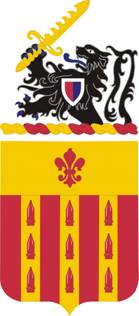
The 12th Armored Division was an armored division of the United States Army in World War II. It fought in the European Theater of Operations in France, Germany and Austria, between November 1944 and May 1945.

The 66th Armor Regiment is the oldest armored unit in the United States Army, tracing its lineage to the 301st Tank Battalion which served with distinction soon after it was formed in the First World War; the 301st trained at Camp Meade, Maryland, where then-Cpt. Dwight D. Eisenhower was an instructor. It has often been rumored that the 301st, the parent unit of the 66th, was first commanded by Col. George S. Patton, but this appears not to have been the case; while Patton was the first officer assigned to the Tank Corps, and while the 301st Tank Battalion was the first unit formed, Patton went nearly immediately to France to train Americans attached to Allied commands. The 301st was the only American heavy tank battalion to have seen action in the war. After the war, the 301st transitioned in the Regular Army to become the 66th Infantry Regiment by way of the 16th Tank Battalion.
The 46th Infantry Regiment is a unit in the United States Army that served in World War II and Vietnam. The 1st Battalion, 46th Infantry Regiment currently conducts Infantry One Station Unit Training under the 197th Infantry Brigade.
The 314th Infantry Regiment is an infantry regiment of the U.S. Army first organized in 1917.

The 50th Infantry Regiment is a United States Army infantry regiment.
The 304th Infantry Regiment currently consists of two battalions in the United States Army Reserve. In the current organizational plan of the U.S. Army, regimental designation is used only in historical tradition; there is no regimental commander, staff or headquarters. The 1st Battalion, 304th Regiment is headquartered in Londonderry, New Hampshire, and the 3rd Battalion, 304th Regiment is headquartered in Saco, Maine.

The 156th Infantry Regiment is an infantry regiment in the United States Army and the Louisiana National Guard. It began as a Confederate Army unit in 1861, and surrendered to the Union at the Battle of Appomattox Court House in 1865. It was reformed in 1878 as a militia unit, and reorganized into the Louisiana National Guard in 1899. It saw support service in World War I. In world War II it served as a guard battalion in Europe, for which it added a lion to its coat of arms to symbolize its service in northern France. It deployed twice during the Iraq war.

The 83rd Field Artillery Regiment is a regiment of the Field Artillery Branch of the United States Army.

The 119th Infantry Regiment was an infantry regiment of the United States Army. The unit was an organic element of the 30th Infantry Division of the United States Army.

The 48th Infantry Regiment is an infantry regiment in the United States Army first formed in 1917.

The 34th Armor Regiment is an armored regiment of the United States Army formed in 1941.

The 6th Field Artillery Regiment is a Field Artillery Branch regiment of the United States Army first activated in 1907 from numbered companies of artillery. It was first organized with two battalions.

The 133rd Field Artillery Regiment is a parent field artillery regiment of the United States Army National Guard. It is currently represented in the Texas Army National Guard by the 1st, 3rd, and 4th Battalions.

The 333rd Field Artillery Regiment is a regiment of the Field Artillery Branch of the United States Army.

The 51st Infantry Regiment is a regiment of the United States Army first established in 1917.

The 58th Infantry Regiment is a regiment of the United States Army first established in 1917.

The 146th Field Artillery Regiment is a field artillery regiment of the Army National Guard first Constituted in 1886 as the 1st, and 2nd Regiments of Infantry.
The 55th Infantry Regiment was a regular infantry regiment in the United States Army.
The 62nd Infantry Regiment was a Regular Army infantry regiment in the United States Army.

The 136th Infantry Regiment is an infantry regiment in the Army National Guard.






















